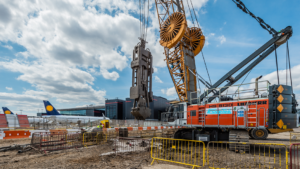Diaphragm and Slurry Walls
Diaphragm walls, ideal for deep retaining structures, offer exceptional leak protection and are well-suited for such applications at Foretek.

Diaphram Walls
Diaphragm Wall Construction at Foretek involves several key steps. Initially, a working platform is established, and a guide wall is constructed. Purpose-built mechanical or hydraulic grabs, suspended from a crane or crawler-mounted rig, serve as diaphragm wall cutters. In cases of exceptional depth or challenging ground conditions, hydromills may be employed. These tools, including grabs and mills, are ‘steerable’ within defined limits, ensuring precision.
Throughout the excavation process, a bentonite suspension is commonly used as drilling fluid to stabilize the cavity. ‘Stop ends’ are then installed, and a pre-made reinforcement cage is positioned. Concrete is tremmied into place, while the bentonite is recovered for cleaning and re-use. The rig subsequently moves approximately five panels away to repeat the process. The completion of an adjacent panel only occurs when the concrete in the initial panel has achieved the required strength.
‘Top down’ construction techniques
Foretek specializes in the construction of exceptionally deep retaining walls using diaphragm walls, frequently in conjunction with ‘top-down’ construction methods. This approach enables simultaneous above-ground building work and deep excavation. Diaphragm walls, a key feature of Foretek’s expertise, consistently deliver superior leak protection for deep foundations.
